Fly into the UK and your first stop will probably be London. But this summer the Olympics are coming to town, and the Queen’s been celebrating her Diamond Jubilee. On the back of it, hotel prices have gone through the roof, accommodation has been booked out, and the capital city is about to be swamped with athletes and visitors. So head north instead and discover three great must-see cities: Belfast, Glasgow, and Liverpool. Here’s why.
Belfast: Our place, our time!
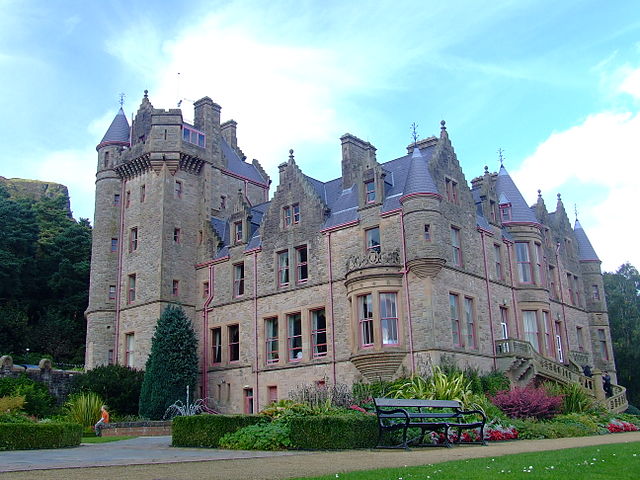
Our place, our time! –Northern Ireland’s slogan for 2012. It could have been Belfast’s slogan 100 years ago when the city launched the mighty Titanic. Back then, the city was buzzing with success. Then the Titanic sank and the ship yards closed down. It was the prologue to “The Troubles.” By the seventies, Belfast had become a dark, strife-torn city. Fast-forward 40 years and Belfast is reclaiming its place in the world. No longer ashamed of its past (and happy to take ownership of its infamous ship again), the brand new Titanic museum, an iconic aluminium-clad building, rises out of the dock wastelands like an ice-clad ship from the sea.
National Geographic has voted Belfast one of the 10 must-see destinations of 2012. Head for the city and see for yourself why it’s now one of Europe’s most exciting and fascinating cities.
It may be a buzzing cosmopolitan city, but it’s also small and compact, with most places easily reached on foot.
Start by jumping on an open-top bus to get a general feel for the place. The tour starts from the city centre, taking in handsome Victorian neo-classical buildings and innovative modern architecture before heading over to the more gritty area of West Belfast, with its political wall murals, memorials, and peace line (a 25ft high wall in places, separating warring Loyalist and Republican communities). The bus then heads out to Stormont, Northern Ireland’s answer to the White House. Along the way, local guides recount the city’s history with a typical mix of in-depth knowledge and Belfast wit.
For an alternative “roots” guide to the city, squeeze into a black taxi for a Tour of the Troubles. The taxi drivers are colourful characters who will give an upfront, insider’s view of the conflict.
[social]
Prefer to walk around a city at your own pace? Restricted to a tight budget? Don’t worry; Belfast is the place for you. It may be a buzzing cosmopolitan city, but it’s also small and compact, with most places easily reached on foot. And another bonus, Belfast has the friendliness of a village. (Where else would a Starbuck’s waiter tell you in detail about his recent trip to China?) Start at the City Hall, a striking baroque building in the centre. Take one of the regular free tours of the interior – or simply chill out on one of the deck chairs scattered around the grounds (You never know the sun just might come out). Next, head down the main shopping thoroughfare past the 50 foot high copper sculptures representing the masts of 8 famous ships built in Belfast, including the Titanic. Turn right into the pedestrianized area of Victoria Place. You’ll soon come to the Victoria Square shopping centre with its many shops, boutiques, and eateries. Take the elevator up to the dome for a free 360 degree view of the city – with the hills on one side and the river Lagan, Belfast Lough, and the sea on the other.
Check out the art and sculpture dotted around the city. Head across Thanksgiving Square, taking care not to trip over the (bronze) sheep being led through the city by their shepherd. By the Lagan, the “Ring of Thanksgiving” by Andy Scott is particularly moving. At almost 50ft high, this metal frame of a woman holding up a ring to the sky is a symbol of hope and peace. Typical of the infamous Belfast humor, the locals have come up with a wittier range of names for the sculpture such as Nuala with the hula, The doll with the ball, and The thing with the ring.
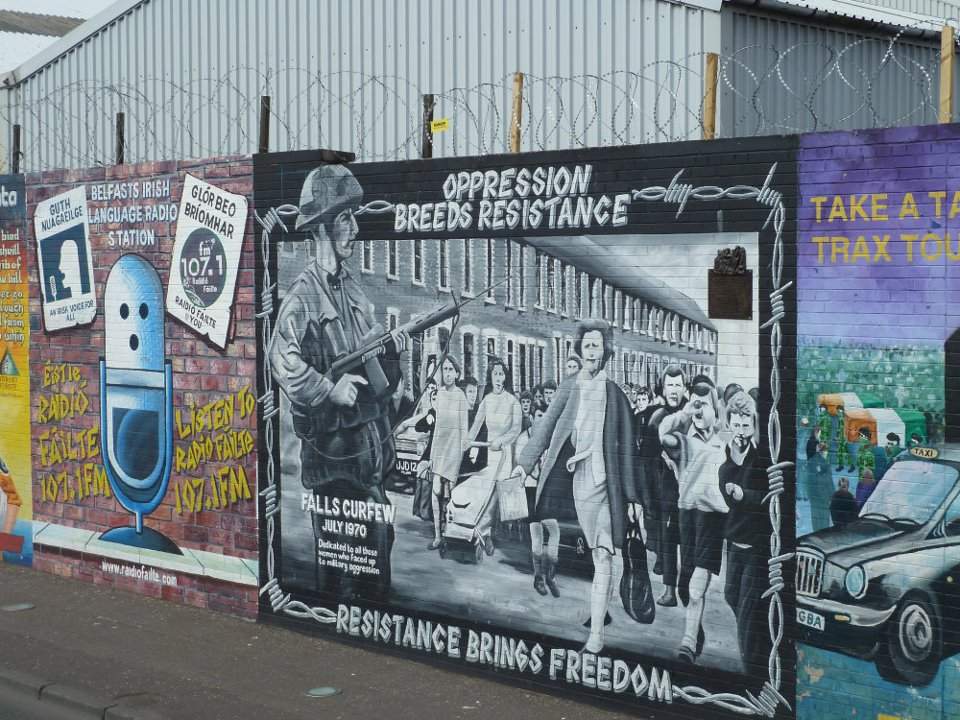
Walk the short distance west of the city center to the Falls Road for a closer look at the homespun wall murals. Artistic expressions of Marxist socialism and political independence, the slogans and paintings pay homage to Che Guevara, Cuba, Palestine, and the Basque Separatist Movement.
No trip to Belfast is complete without a trip to the Riverside and the Titanic Quarter. Join a Titanic walking tour and explore the Titanic pump house and the drawing office. Climb down 44 feet to the bottom of the dry dock and you’ll begin to get a sense of the sheer scale of the Titanic. Inside the Titanic Museum, walk through the history of Belfast. As your silhouette mingles with the Victorian figures that hurry across huge projected images of Victorian Belfast, you’d be forgiven for thinking you’ve stepped back through history and are walking with ghosts. Outside, the towering cranes of Samson and Goliath are permanent reminders of Belfast’s greatness.
Where to eat
McHugh’s bar and restaurant is Belfast’s oldest surviving building (1711). Situated in Queen’s Square, the historical commercial centre of the city, McHugh’s serves traditional Irish food with a modern twist. Try the massive Flintstone-esque “on the rock” steaks (served on slabs of slate) – or if meat is your poison, there are tasty vegetarian options such as champ (Creamed potatoes with scallions).
Wetherspoon is a chain of pubs in the UK, serving descent comfort food (and beverages) at very reasonable prices. Try The Bridge House on Bedford Street. (Wetherspoon pubs are located all over the UK).
Where to rest your head
There’s a wide range of hotels, Bed and Breakfast accommodation, and self-catering options to suit all budgets. There are also a number of backpackers’ hostels dotted around the city. For something different, try the Blackhead Lightkeepers’ Houses overlooking Belfast Lough and just a 40 minute train ride from the centre of the city. It offers self-catering with dramatic sea views from a rocky cliff top.
Getting around
There are scheduled flights into Belfast International from all over Europe and world-wide destinations. A number of no-frill flights fly to Belfast City Airport from other parts of Ireland and the UK. There are sailings from Liverpool to Belfast and from Stranraer/Cairnryan in Scotland (with a connecting train service). Getting around Belfast is easy as there’s a good network of buses.
Out of town
Explore the Antrim Coast, where the road hugs the Irish Sea. Visit hamlets squeezed in at the base of sea cliffs or swing across the Carrick-a-Rede fisherman’s rope bridge traversing a 100ft deep chasm. At the Giant’s Causeway leap across weird hexagonal columns of basalt rock. Run amok through ruined castles and follies perched on the edge of cliffs. All these places can be visited from Belfast on a day trip.
Find a flight to Belfast, book a hostel in Belfast, and check out our new Belfast Travel Guide.
Glasgow: Get down and dirty
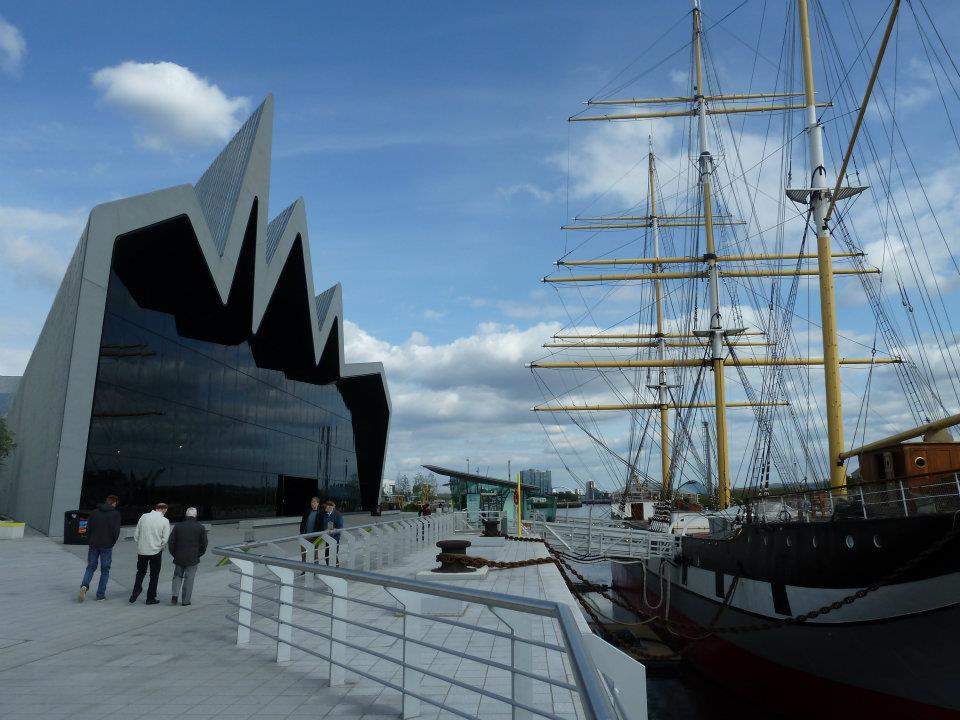
Glasgow has real character: It’s smart, witty, gritty, vivacious, and alive. How can it be anything else – for it’s here in this town that great characters like Craig Ferguson and Billy Connelly came of age. Forget bad, bad food such as deep-fried Mars candy bars (surely an urban myth) and the nuclear-orange, sugar-loaded national soda drink, Iron Brew. Forget thick, incomprehensible accents and mean streets, alcohol-fueled pub brawls and the Glasgow kiss (a head butt): Glasgow is cool, hip, and vibrant – yet full of history. No mystery then that Glasgow was made European City of Culture in 1990. Here’s the lowdown.
Take one the city buses down to the Clydeside. Regeneration is happening at a cracking pace on the old industrial wastelands. State-of-the-art architecture is changing the Clydeside skyline forever with iconic buildings such as the smart new Riverside (transport) Museum, the futuristic Armadillo (arena and conference centre), and the glass crescent-shaped science mall standing next to the Glasgow Tower – currently the highest tower in the world capable of rotating 360 degrees.
Here Glasgow’s elite attempted to outdo their neighbour with the largest family vault, the highest monument, the best quality stone, the most detailed mason work, the grandest sculpture, or the finest inscription.
Over in the West End you’ll find a more mature Glasgow – but just as trendy and happening. The elegant Victorian tenement blocks have been hosed down and spruced up, losing decades of black industrial grime to reveal once again the warm hue of red sandstone. Glasgow University, the 4th oldest in the English-speaking world, is Harry Potteresque in stature with its dramatic gothic buildings, great arches, walled cloisters, and turrets. Take a student tour to get an up-close and personal view of the university – or simply wander around the buildings by yourself. The rest of the West End is filled with leafy parks, hilly buffs, world-class museums, smart boutiques, fine restaurants, alternative cafes, and stylish wine bars alongside the more down-to-earth spit-and-sawdust pubs and clubs.
From the West End, make your way in to the Cathedral Quarter. Climb up the Necropolis, a large eerie Victorian cemetery. For real atmosphere, head up there on a drizzly, misty day – or at dusk. Creep past obelisks, Celtic crosses, toppled urns, beheaded statues, and ivy-covered mausoleums. You’ll find all of Glasgow’s great and good from “The Empire’s second city” have been buried here (or so it seems): esteemed men of the cloth, rich industrialists, sea merchants, and tradesmen, as well as philosophers, actors, artists, sculptors and writers (including the author of Wee Willie Winkie). At the top of the hill, the cemetery looks like a high-rise city of the dead. Here Glasgow’s elite attempted to outdo their neighbour with the largest family vault, the highest monument, the best quality stone, the most detailed mason work, the grandest sculpture, or the finest inscription. Wander through the paths, taking time to read some of the inscriptions. The headstones are one-page books of story and history.
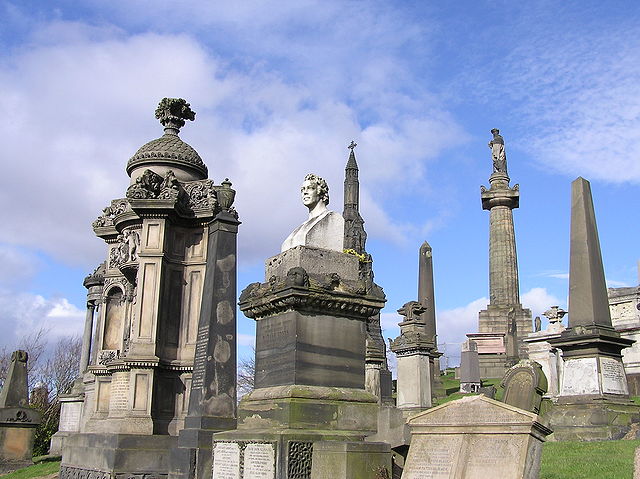
Retrace your steps back over the “Bridge of Sighs” and out of the Necropolis, head straight into the cathedral. It’s an imposing Gothic church that was built in the Middle Ages. Saint Kentigern (affectionately known by the locals as St Mungo) supposedly built the first Christian church in Scotland here. The tomb of the saint lies in the lower crypt. You can view the story of St Mungo -and the miracles associated with him – in one of the stained glass windows. The bird that never flew, the tree that never grew, the bell that never rang, and the fish that never swam. These symbols form the Glasgow coat of arms and can be seen all over the city.
Where to eat
The Black Sheep , a small bistro in Clarendon Street in the West End serves incredibly tasty Scottish fare. Try their black pudding, Stovies (potato and beef stew), haggis (offal in a sheep’s stomach), and you will be pleasantly surprised. The deserts are to die for. Tip: order a starter, small main, and pudding. It’s more than enough.
Flavorsome Scottish food is served at the Two Fat Ladies with branches in the West End and City Centre. The lunch time menu is particularly good value.
Where the Monkey Sleeps in the city centre serves a wide variety range of good value meals. The menu itself makes for interesting reading with dishes like child of the goat,firewalker, and serious operation.
Where to rest your head
There are plenty of great hotels and guest houses to choose from and to suit all pockets. For real style, a glorious location and good value, however, book the Youth Hostel overlooking Kelvingrove Park.
Getting around
Glasgow International Airport is only 8 miles from the city center and is well served with taxis and buses. In Glasgow itself, getting around the city is easy with a comprehensive network of buses, trains, and the underground railway system, known affectionately by locals as “The clockwork orange.”
Out of town
Just a hop-and-a-skip away are the bonnie, bonnie banks of Loch Lomond. Take one of the tours up to the Trossachs and the Highlands of Scotland. Grab a coffee or a pint on the veranda of the Lodge on Loch Lomond at Luss and gaze out at the hills, the lake, and its many islands. Breath in the clear, crisp air ,and enjoy the pure, pure light of the north – the perfect contrast to the gritty, get-down-and-dirty streets of Glasgow.
Find a flight to Glasgow and read our new Glasgow Travel Guide
3. Liverpool: She loves you, yeah, yeah, yeah
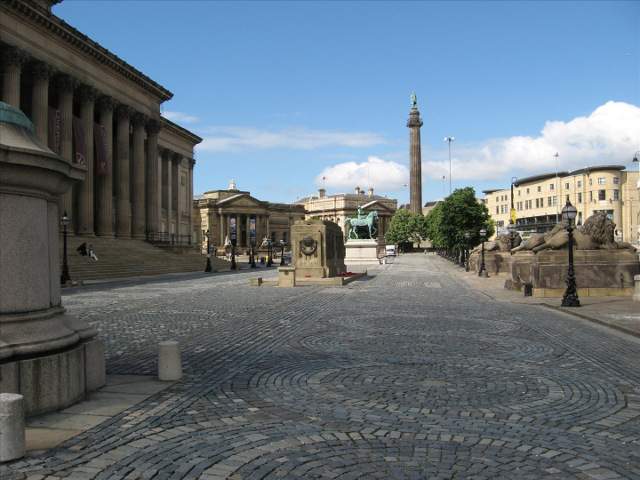
And you will love Liverpool, too …
Liverpool: the place where the Beatles grew up and came of age. John, Paul, George, and Ringo were four ordinary lads from very ordinary places who grew up to produce extraordinary music. The Beatles embody the vibrant spirit of Irish working-class Liverpool: bold, cocky, and straight-talking. The city that shaped them served them well for the four young Liverpudlians went on to create music that pushed the boundaries of popular music: fearless, confident, unconventional, and experimental. They were a breath of fresh air. You can take the Beatles Bus Tour, visiting the Fab Four’s stamping grounds, including Penny Lane and Strawberry Fields, or take a trip to Mendips and Forthlin Road, Lennon and McCarthy’s modest childhood homes, faithfully reproduced by the National Trust. Closer to the city center, (free and walkable) is Matthew Street and The Cavern where the Beatles first played. Have a drink (surprisingly good value) or enjoy some of the current local bands playing there. Outside is a fascinating music wall of fame. It seems anyone who’s anyone in the British music scene has played here. The individually named bricks include The Who, The Rolling Stones, The Kinks, Arctic Monkeys, Travis, Adele, and Jessie J. James.
The wood, the artistic detail in the Stations of the Cross and the large slices of brilliant color (cobalt-blue, marine-green, and burnt-sienna) radiating from the stained-glass windows are breathtakingly beautiful.
But Liverpool is much more than just the Beatles. It’s a UNESCO World Heritage Site, and like Glasgow, was made European City of Culture (2008). Head for the Docks with its heady mix of grandiose Victorian merchant buildings and twenty-first century glass and concrete high-rise offices. The old wharfs around Albert Dock have been beautifully restored and are filled with wine bars, restaurants, and boutiques. Make sure to visit Tate Liverpool (free entry). Whatever you feel about the merits of modern art, it is never less than entertaining.
From the Docks, wander through the back streets to Liverpool’s Anglican Cathedral. This imposing neo-gothic church is the fifth largest in the world, and its sheer scale and forbidding structure is mind-blowing. Make your way further up Hope Street. Pause to look at the A Case Study sculpture – what looks to be at first glance piles of abandoned luggage strewn across the pavements. On reading the labels with the names of famous locals, you begin to understand just what a creative bunch the Liverpudlians are.
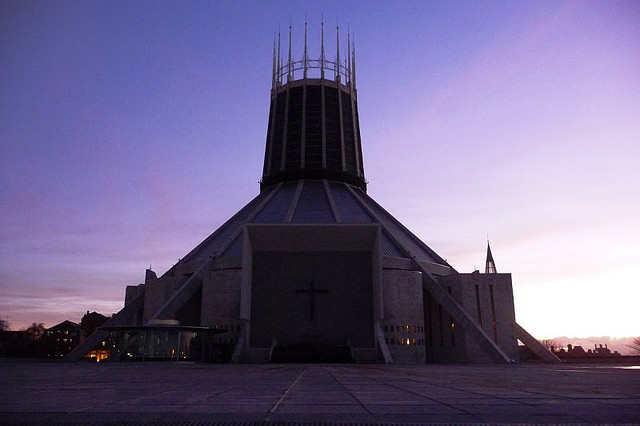
Reaching the top end of Hope Street, you’ll see the strangest sight – something akin to a huge concrete crown. This is the Metropolitan Cathedral of Liverpool (or Paddy’s Wigwam to the locals). While the Anglican Cathedral looks back to the great classical buildings of the past for inspiration, its Catholic sister cathedral is totally modern, futuristic even. Climb the steep steps to see this brutal concrete structure soar up into the sky. What it lacks in classical beauty, it makes up for with sheer impact. Whether you find it ugly or inspiring, you certainly won’t be indifferent. But no one can question the beauty of the cathedral’s interior. Inside, this 360 degree building feels womb-like, warm and all-encompassing, despite its massive circular space. The wood, the artistic detail in the Stations of the Cross and the large slices of brilliant color (cobalt-blue, marine-green, and burnt-sienna) radiating from the stained-glass windows are breathtakingly beautiful.
Where to eat
You can’t come to the UK without having a curry (the national dish, some would say). Try the business lunch at Maharaja for light, flavorful food – selection of curries, bread, rice, and pudding. Maharaja is just a few minutes from Lime Street railway station.
And for the other national dish … you’ve got to have fish and chips from the chippy. Steve’s on Ashfield Road is said to have the best fish and chip shop in town, but if you want to stay in the city center, there are numerous takeaways scattered around.
Where to rest your head
To complete the Beatles experience stay at the Hard Day’s Night hotel with (you’ve guessed) Beatles themed rooms. A little bit out of town but excellent value for money is the Snooze Guest House. There are plenty of B&B’s and hostels in and around the city, too.
Out of Town
Take the train or the bus from the centre of Liverpool out to Crosby Beach. The industrial views back towards Liverpool docks have a bleak poetic beauty. It is: however, the 100 life-sized, cast-iron figures, gazing out to sea along this 3 mile long beach that will really stir your soul. The figures (Another Place), made from the body cast of artist Anthony Gormley (famous for his Angel of the North), are lumpy, sea-eroded sculptures that stand forlornly on the sand or partially submerged in the water from ankle to neck. They are a foreboding but strangely moving sight against the cold, grey Irish Sea.
Find a cheap flight to Liverpool, book a hostel in Liverpool, and check out the new Liverpool Travel Guide.
Photo credits: Stubacca, Finley McWalter, R/DV/RS, yellow book, all others courtesy of the author and may not be used without permission.
